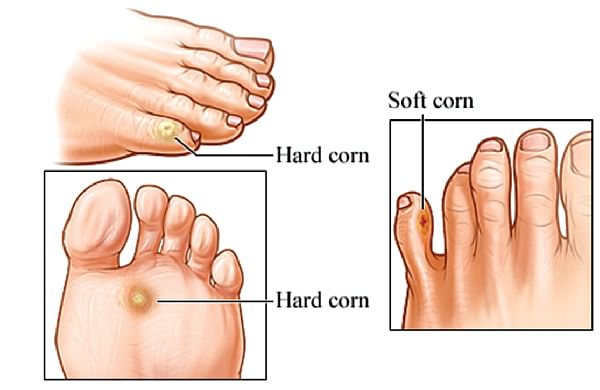Cure your Corn
Cure your Corn

Have you ever felt a small, hard discoloured bump or lump underneath the skin of your foot? You're either on your feet all day or your toes are crammed into your latest designer shoes. Or maybe you put extra pressure on your hands while using tools. Either way, you can grow those ugly looking monsters called corns and calluses beneath your skin. Don't worry; these unsightly and sometimes painful lumps can be done away with under expert's supervision.
Corns and calluses are thick, hardened layers of skin which most often develop on the feet and toes or hands and fingers. They develop as our skin tries to protect itself against friction and pressure. If you're healthy, you need treatment for corns and calluses only if they cause discomfort. For most people, simply eliminating the source of friction or pressure makes them go forever. However people who have diabetes or any other poor health condition that hinders circulation to their feet are at greater risk of developing corns and calluses.
Causes
Pressure and friction from repetitive actions cause corns and calluses to develop and grow. Some causes include:
! Ill-fitting shoes. A pair of shoes that fits just right can save you from growing this kind of foot disease. When shoes are too tight or have high heels, they compress areas of your foot. When they're too loose, your foot may repeatedly slide and rub against the shoe. Your foot may also rub against a poorly placed seam or stitch inside the shoe.
! Skipping socks. Wearing shoes and sandals without socks can lead to friction on your feet. Socks that don't fit properly also can be a problem.
! Using hand tools. Calluses on your hands may result from the repeated pressure of using tools on the job, around the house or in the garden.
Home remedies to fight corn
If you have no underlying health problems, these suggestions may help clear up corns and calluses:
! Wear comfortable shoes and socks. Stick to well-fitting, cushioned shoes until your corn or callus disappears. Also, choose socks that fit properly and are made of a polyester-cotton blend because they absorb moisture away better than all-cotton socks do.
! Soak your hands or feet. Soaking your hands or feet in warm, soapy water softens corns and calluses. This can make it easier to remove the thickened skin.
! Thin your thickened skin. During or after bathing, rub corns or calluses with a pumice stone or washcloth to help remove a layer of toughened skin. Don't use a sharp object to trim the skin. Don't use a pumice stone if you have diabetes because your risk of infection is higher.
! Moisturise your skin. Apply moisturizer to hands and feet to help keep your skin soft.
Things that you should keep in mind
! Wear shoes that give your toes plenty of room.
! If you have diabetes or another condition that causes poor circulation, consult your doctor before attempting to treat corns and calluses on your own.
! Wear padded gloves when using hand tools. Or try padding your tool handles with cloth tape or covers.
! Don't try paring down thickened skin or trimming a large corn yourself as it could lead to an infection.
! If a corn or callus persists or becomes painful despite your self-care efforts, medical treatments including surgery can provide relief.
! When there isn't a corn or callus on your feet, a good foot-soaking on a daily basis is recommended, especially at the end of the day. This helps alleviate any pain and is most relaxing. It will keep the feet soft and less prone to calluses.